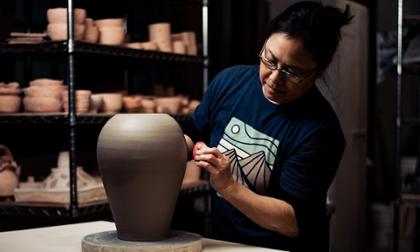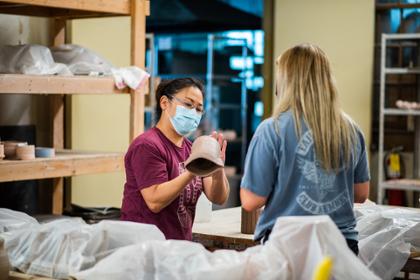“My journey began with the message, ‘Girls don’t do that’,” she said, “and it seems I have spent a lifetime proving ‘them’ wrong.”
Today, now a Japanese American, Kiefer is an award-winning clay artist with a passion for passing on to others what she has learned in hopes of making a difference.

Kiefer recently took on the role of heading up Pittsburg State University’s ceramics program and studio in the Department of Art, and she wasted no time in kicking off her first community-based project: Artists Against Hunger.
Sometimes known by the name “Empty Bowls,” the project has been done in communities across the U.S. as a way to benefit food pantries and those who need them.
“I am not from here, and I want to have a good relationship with people,” Kiefer said. “So, I do my thing, which is a little thing. And then I connect with others. Each person can do something small, but together we can do big things.”
Finding her voice
Growing up, Kiefer knew that even poor homes were full of small, functional pieces of ceramic art.
“In our kitchen were a variety of small saucers, condiment bowls, rice bowls, individual plates in every size shape and color,” she said. “The objects were chosen for the food they would hold.”
At the entrance to her home was an Ikebana display: a flower, grass and twig array set into a ceramic tray, and her mother taught Ikebana and Japanese tea Ceremonies.
When she came to the U.S. after high school in pursuit of a higher education — a dream, she said, because she “knew how much education would open up my eyes” — she chose to major in mechanical engineering.
It was when she discovered an art class in a university catalog that her path veered to include ceramics and she found she loved it. In addition to an associate’s degree in engineering, she went on to earn a bachelor’s of fine arts in 3D studio art and a master’s of fine arts in ceramics.
She has since done artist residencies abroad, and her awards are lengthy and varied, from juried art shows to a letter of commendation from the Ohio State Senate and House of Representatives. Through the years, she had the support and encouragement of her husband, Steve, and her own determination.
“As a female, I wanted to have a strong voice in the world of clay art,” she said.
That desire shows up in her art depicting female Samari, or military nobility. And, it shows up in her art depicting various women from other cultures in medieval times, including Italy and Spain.
“I put myself in her role,” she said of each of those women. “They were in different times and places with different struggles, but we also are very much the same as those women.”
Artists Against Hunger
It was while working at a public school in Ohio that she noticed how hunger among students made it hard for them to focus. She learned that one in four children don’t have access to food over the weekend. And she knew she wanted to be part of a solution.
In 2010, Kiefer started Artists Against Hunger, an Empty Bowls project, in western Ohio, and took it with her when she became an instructor at a college in Idaho. She is continuing her efforts at Pittsburg State.

Last month, she invited artists, current students, and alumni to the Porter Hall Ceramics Studio to craft dozens of bowls from lumps of clay in a bowl-throwing party. “Throwing” refers to a method of forming vessels on a potter’s wheel. The bowls are then dried and put into a kiln. Then, a glaze is applied, the bowl is again put in the kiln, and it’s “fired.” No two bowls are the same.
From Nov. 15-18, she’ll have some of the bowls and information about the project on display in the Overman Student Center. Then, on Jan. 22, the Artists Against Hunger event will be held at Pittsburg's Memorial Auditorium, 503 N. Pine, where bowls will be sold from $10 to $25.
Kiefer hopes to have 500 bowls ready.
All of the proceeds will benefit local food banks including Wesley House, the Community Foundation of Southeast Kansas, St. Peter’s Episcopal Church, and the Pittsburg Church of Christ.
“It sounds like it’s helping other people, but it’s helping me, too — it’s giving me a good feeling,” Kiefer said. “The object is not to create a great work of art. It is to represent that we want to provide for people. At the same time, it will feed us as artists. It will feed our souls because we are creating.”
Learn more:
Art Department